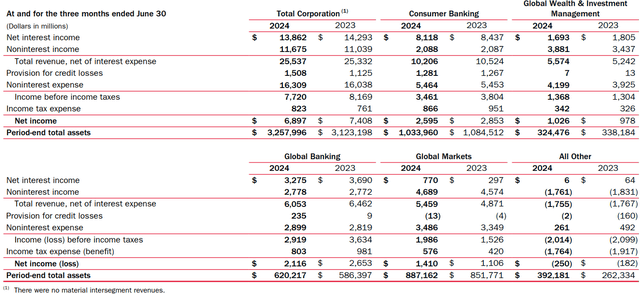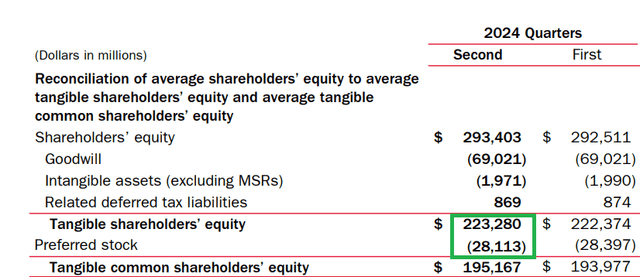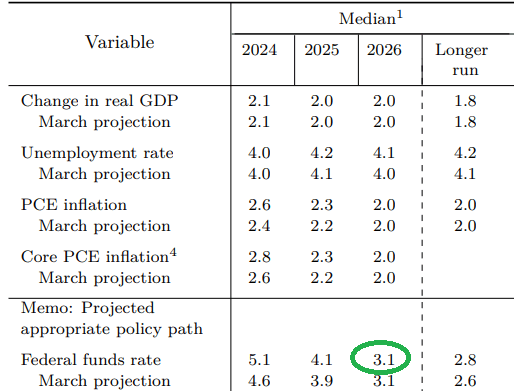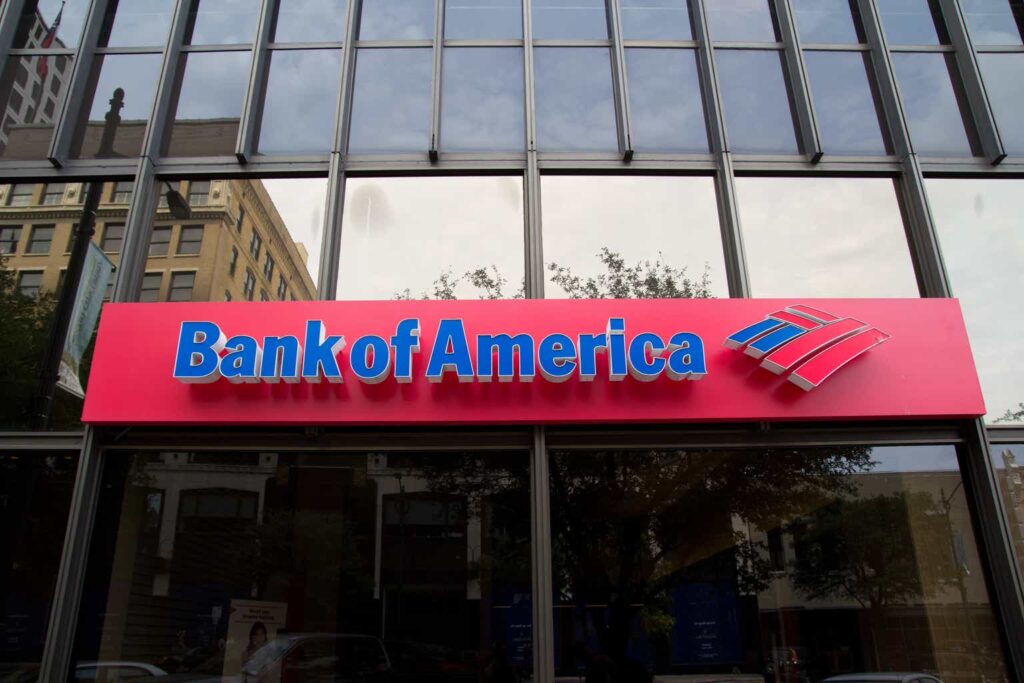Introduction
Bank of America’s 4.125% fixed-rate series PP preferred shares (NYSE:BAC.PR.P) have performed in line with the iShares Preferred and Income Securities ETF (PFF) so far in 2024, delivering a circa 6% total return:
BAC 4.125% Preferreds vs PFF in 2024 (Seeking Alpha)
I think the 4.125% preferred shares may outperform should the Fed start easing monetary policy and could provide even greater upside in the event of an eventual US recession. I estimate the series PP shares offer an 11% annualized return potential to my year-end 2026 target price of $21.2/share. Risks should be limited thanks to excellent dividend and common equity coverage ratios, notwithstanding the need to strengthen the bank’s capital position.
Company Overview
You can access all company results here. Bank of America (BAC) reports results in four business segments, namely Consumer Banking at 37% of Q2 2024 revenues, Global Wealth & Investment Management at 21%, Global Banking at 22%, and Global Markets at 20%, with the remaining operations booked in All Other.
Results by business segments (Bank of America form 10-Q for Q2 2024)
Preferred coverage metrics
In Q2 2024 Bank of America paid $315 million in cumulative preferred dividends, indicating that net income of $6.9 billion covered preferred dividends almost 22 times – an excellent coverage result.
The bank had $28.1 billion in cumulative preferred shares outstanding as of the end of Q2 2024, indicating they were covered by tangible shareholders’ equity almost 8 times – again providing a very good margin of safety:
Cumulative preferred shares relative to tangible shareholders’ equity (Bank of America form 10-Q for Q2 2024)
Considering that BAC trades at a premium to its tangible book value, the coverage by market capitalization is even better, at about 10.9 times.
Capital Position
Bank of America ended Q2 2024 with a standardized CET1 capital of 11.9%, flat Q/Q, providing a buffer of 1.2% relative to the 10.7% regulatory requirement which is due to come into effect from October 1, 2024 (current requirement is only 10%). I would expect BAC to emphasize capital buildup in the short term as the 1.2% buffer is not particularly high in itself.
The case for the Series PP preferred shares
You can view all of Bank of America’s preferred issues here, together with their prospectuses (the Series PP prospectus is available here). Over the last three years, the Series PP shares have underperformed the Bank’s common stock by circa 17% and currently trade around $18.71/share, well below their par value of $25:
Series PP vs BAC common stock over the last three years (Seeking Alpha)
The main culprit behind the underperformance was the Fed rate hiking cycle of 2022-2023 which provided ample fixed-income alternatives and reduced the appeal offered by the Series PP shares. This has resulted in the Series PP preferred shares currently trading at a dividend yield of 5.5%, which is an excellent starting point considering the robust coverage by both net income and common stock equity.
I think the preferred shares will also deliver some capital gains over the next few years, largely dependent on the Fed cutting interest rates from the current 5.25-5.50% target range. Considering that the preferred shares fell from about $25/share in 2021 to the current level well below par, representing a capital loss of around 25%, I think the Series PP shares will recoup some of these losses, but not all of them.
I estimate that should the Fed cut rates to about 3.1% in 2026, as forecast in its June 2024 Summary of Economic Projections, the Series PP shares may recover some 40% of their price decline:
Outlook for macroeconomic indicators (Federal Reserve June 2024 Summary of Economic Projections)
A recovery of 40% in the Series PP share price would result in a fair value of about $21.2/share for the Series PP or a capital gain potential of around 13.3% over the next 28 months.
Annualizing the 13.3% return results in an annual capital gain of 5.5% until the end of 2026, or a total return potential of circa 11% at the current share price:
| Preferred Series | Annual dividend yield | Annual capital gain | Cumulative annual return | Year-end 2026 Target Price |
| Series PP | 5.5% | 5.5% | 11% | $21.2/share |
Source: Author calculations
I would add that the preferred shares offer further upside in the event of a US recession (which Goldman Sachs (GS) currently puts at about 20% over the next twelve months), as the Fed is likely to bring rates to below 3.1% in such an environment. Of course, the incremental upside will depend on the outlook for normalization of monetary policy and the depth of the recession, with a deep economic downturn potentially resulting in a higher price for the Series PP preferred shares.
Other preferred shares to consider
While my article focuses on the Series PP shares, you may want to consider other fixed-rate preferred shares, such as the 4.25% Series QQ (BAC.PR.Q) and the 4.375% Series NN (BAC.PR.O) – these issues offer a similar yield and capital appreciation potential.
Obviously, if you are expecting a significant amount of Fed rate cuts you may want to avoid the floating rate preferred shares such as the Series MM (BAC.PR.M).
Risks
While current coverage metrics are exceptional, I would note Bank of America did not perform particularly well on the Federal Reserve’s 2024 annual stress tests. The results available here showed that Bank of America’s CET1 capital would drop to 9.1%, well below JPMorgan Chase (JPM) at 12.5%, and even Citigroup (C) at 9.7%. As you may have guessed, of the big four US banks BAC only outperformed Wells Fargo (WFC) which scored the worst with a CET1 ratio of 8.1%.
Coupled with the capital buffer of only 1.2% against the new October 2024 regulatory requirement, it is clear that BAC needs to strengthen its capital position.
The other risk I would point to is that the dynamic between Fed rate cuts and the price of the series PP fixed-rate preferred shares is not entirely predictable. I would certainly say that rate hikes negatively affect the series PP share price, hence rate cuts should have the opposite effect, but whether the series PP shares reach my $21.20/share year-end 2026 target price is uncertain.
Conclusion
Bank of America’s 4.125% series PP preferred shares have underperformed the bank’s common stock over the past three years, largely due to aggressive Fed rate hikes. I expect the Fed to reverse course in the next few years, eventually reaching its 2026 forecast Fed funds rate of about 3.1%. This will likely allow the series PP preferred shares to recover some of their recent losses, potentially delivering a small double-digit annual gain.
Current dividend and common equity coverage ratios are excellent and I expect the bank to strengthen its capital buffer in light of higher requirements coming into force in October 2024. This should address any concerns you may have about safety and allow the preferred shares to outperform in a recessionary environment, which is typically a challenging time for banks.
To conclude, I think the series PP shares offer an excellent way to add bank exposure in the current economic environment, and hence rank them a buy.
Thank you for reading.
Editor’s Note: This article discusses one or more securities that do not trade on a major U.S. exchange. Please be aware of the risks associated with these stocks.
Read the full article here



